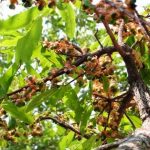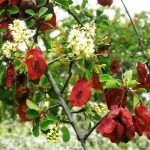TREE LIFE
January 2006
MASHONALAND CALENDAR
Tuesday 3rd January: Botanic Garden Walk. Meet Tom in the car park at 4.45 for 5 pm. We will continue with the family Combretaceae.
Sunday 15th January: After all the wonderful rains that have fallen in the Harare area, a return visit to Kutsaga Tobacco Research Board’s property on the airport road will, we think, be an interesting and worthwhile outing.
Bring your lunch and a chair for an all day outing.
Saturday 28th January: The venue for Mark’s Walk is still to be confirmed. Please phone Mark or Maureen for details.
MATABELELAND CALENDAR
Please contact Jean Wiley or Gill Short for details of the next Matabeleland function.
CARLI’S FARM, ARCTURUS: 20 NOVEMBER 2005
Today’s outing saw us on the Gardiner Rd, near Arcturus, not far out of Harare, at the smallholding of Aldo and Alison Carli. One of the great pleasures of our monthly outings, quite apart from escaping from city life for a day, is the warm welcome we receive from our hosts. This was especially true of this day and we were greeted with tea and snacks under a shady veranda.
The first tree of the day was in fact an exotic, Brachychiton discolor. The Tree Society tends traditionally to turn its nose up a bit at exotic trees. Our interests tend to lie in native trees in native habitats, but in fact, there often are points of interest in exotics – often, for example, they are related to our native species.
The Brachychiton used to be in the genus Sterculia – and its close relationship to that genus could be seen in (1) the palmately-lobed leaves (2) the follicle-like fruits which split open on one side and (3) the flowers which lack petals – the pinkish objects we see are in fact the calyx. As the species name suggests, the leaves are discolorous; namely green above and paler green-grey beneath.
A number of these trees are planted in G. Silundika Avenue near the 4th Street car park. In addition to all the features described above, their trunks are somewhat swollen, a bit like a half-hearted baobab tree.
Before the walk, we split into two groups: a beginners’ group (as usual kindly led by Rob Burrett) which went up the hill by a steepish route and a more experienced group (led by me) which walked along a contour near the bottom of the hill before striking up to the top at a later stage.
Incidentally, the GPS showed an altitude of 1500 m at the bottom and 1550 m at the top, so we were not far off the altitude of Harare.
Our walk today started off through miombo woodland dominated by Julbernardia globiflora (mnondo) (certainly more Julbernardia than Brachystegia) and the woodland also contained Uapaca kirkiana (the mahobohobo). It was a hot and dry time of year with not very much was showing in the herbaceous layer. However, there were some very striking fireballs flowering among the rocks. These are Scadoxus multiflorus (formerly called and better known to many, as Haemanthus multiflorus). Unfortunately, the genus Haemanthus is reserved for a group of mainly Cape species and all ours changed to the new genus.
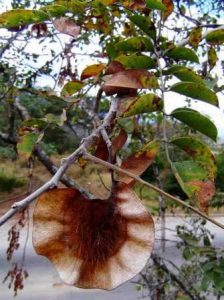
Pterocarpus angolensis. Photo: Bart Wursten. Souce: Flora of Zimbabwe
Another tree seen was the mukwa, Pterocarpus angolensis. We see it so often that we don’t always realise what a striking species it is with its rough bark, dark red slash and the remarkable winged fruits with their prickly defences. (“Hedgehog on a life raft” as someone called it). The leaves are pinnate and the leaflets are arranged alternately along the rhachis – very much a feature of many tree legumes.
Lannea discolor was there in fruit. This has thick branches, from the apex of which emerge flowering spikes, usually in about September. By this stage of the year, the flowers had become fruits. Also in flower was Ozoroa insignis (the Raisin bush – so called because of its raisin-like fruits); the flowers are borne in terminal, sometimes axillary, panicles and are white. This is a simple-leaved member of the family Anacardiaceae.
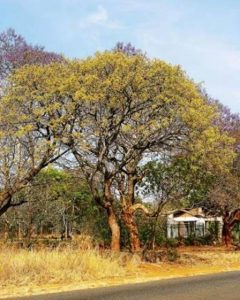
Lannea discolor. Photo: Meg Coates Palgrave. Source: Flora of Zimbabwe
There were problems identifying the terminalias. There were undoubted plants of Terminalia stenostachya, recognised by their relatively large leaves and twigs which bear craters (arising from old leaf attachments) but do not have pealing bark on the young twigs. There was also clear Terminalia sericea with “tweeling pigs”. Problems arise with trees which appear to be intermediate between T. stenostachya and T. sericea; these have smaller leaves than typical stenostachya but have peeling twigs, sometimes also with the craters. Similar trees occur in the Mukuvisi Woodland and it not clear to me what they are.
Other common trees seen included the Christmas berry (Psorospermum febrifugum), Ekebergia benguellensis (Woodland dogplum), Vangueriopsis lanciflora (the False wild medlar – with its distinctive bark) and Monotes engleri.
After a while we arrived at a rocky area. Here were more quite stunning Scadoxus in flower, true (as far as we could tell) Terminalia sericea, Ximenia caffra (in fruit), Tetradenia riparia and the compound leaves of a climbing Dioscorea.
A little later we emerged on to a road and began a steady ascent to the summit ridge. Here was Eriosema ellipticum, a legume usually indicative of high rainfall woodland and Maytenus undata, the species of rocky places. Folding a leaf of the latter produces a broad white waxy line – and this, together with the distinctive smell, were demonstrated in the field.
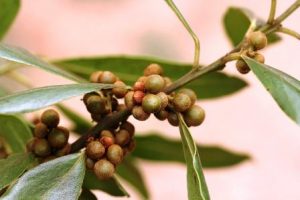
Euclea natalensis. Photo: Bart Wursten. Source: Flora of Zimbabwe
At the top, we met up with the other group. Here were Diospyros lycioides, Flacourtia indica and (planted) Diospyros nummularia. We then made the fairly steep descent back down to the farmhouse. One or two new species were seen: Brachystegia glaucescens (Mountain acacia), Ficus natalensis and Euclea natalensis.
In the woodland we found a small woody Vernonia, V. glaberrima. It is quite frequent around Harare but is a nondescript species and is easily overlooked. On our return, the Carlis’ generous hospitality continued as we were offered wine, beer and food to go with our lunch. We sat outside in a shaded area – and everything seemed to be well with the world!
After lunch, a significant number went on a more gentle walk led by Rob. There was a steady flow of new species. One puzzle shrub we eventually decided was Flacourtia indica. Finally, we wended our way back to the homestead for our departure to Harare.
Our great thanks go to the Carlis for the generous hospitality and welcome.
-Mark Hyde
MISTLETOE
Mistletoe (Viscum album), highly placed among the world’s mysterious and magical plants, famous since the Druids, was particularly revered if growing on the oak, when it joined the stalwart qualities of tree and plant. It was neither tree nor shrub, and part of its mystery for the Celts, at least, lay in its parasitic suspension between earth and sky. When all was winter dead, the grey-green leaves and luminous pearly-yellow berries of mistletoe encapsulated the host’s life force. On the Druids’ holy oak the effect was even more dramatic and the viscous pearly pulp of mistletoe berries was represented as the oak-tree god’s semen.
To Norsemen mistletoe was ominous. Goddess Frigg made all swear never to harm Balder the god of light, but she over-looked the insignificant mistletoe plant, deeming it too young to swear the oath. Loki, spirit of evil, gave a mistletoe dart to Höd, the blind god, who, unseeing, threw it and killed Balder. (Robert Graves set himself the task of making a mistletoe dart to find if such a death were possible. He found it was.)
Venerated from the first, sacrificially gathered, mistletoe is most effective, said Pliny, if cut with a golden knife on the correct day of the moon (as to which, opinions differed) without the use of iron; mistletoe for ritual use must fall into a white cloth without touching the ground. Midsummer Eve and May Day were auspicious days for plucking. Druids held that mistletoe (the ‘golden bough’ of myth), sent from heaven, was visual evidence of the gods’ love for the oak. To fell a mistletoe-bearing oak invited disaster.
Legend stated that the Hay family of Errol, Perthshire, would prosper only as long as the mistletoe-oak on their land near the Falcon Stone flourished. It protected the family against witchcraft and its infants from becoming changelings. When the estate finally passed out of the family it was said that the oak had been felled shortly before.
Mistletoe symbolised peace and hospitality, opened all locks, protected the house at solstitial festivals from witches, sorcery, fire and lightning. Indeed, it was itself a lightning plant of twisting form and yellowish berries. Farmers in the Ozarks hung mistletoe in their smoke-houses ‘to keep the witches off’ the meat”. In Normandy it de-flea’d feather beds. A sprig in a cradle protected the infant from the dangers of being snatched by fairies. In a Staffordshire continuity charm, a sprig of last year’s mistletoe was burned under this year’s pudding to carry Christmas luck forward. Lest fertility be rejected, it was unlucky to omit mistletoe from decorations or, equally incorrect, to bring it in before Christmas Eve. Italian women carried a piece of mistletoe to induce conception. The golden tones of mistletoe’s foliage and berries made it, by homeopathic magic, an aid to locating treasure in the earth. Its resemblance to male genitalia gave the plant strong fertility connections. ‘Kissing under the mistletoe’, a lively survival, was once a fertility rite. In some counties mistletoe must be burned after Twelfth Night, lest those who kissed under it never marry. In another ritual, a girl must steal a berry, swallow it, then prick her lover’s initials on a leaf and stitch it to her clothes near her heart. While the leaf remains in place he will remain ‘attached’. Worcestershire kissing bunches swung from the ceiling year-round until replaced by new ones, when the old were burned. Then a steady flame indicated a faithful husband, spluttering an irritable one. An elderly Shropshire couple confessed that they had never lacked a mistletoe bunch in the house during sixty years of married life. Mistletoe leaves and berries were ingredients in an Ozarks’ love potion so secret that no bystander was allowed near the steaming kettles when it was being prepared. In Australia, a sprig at the bedroom door gave a couple sweet dreams. The cowshed was not forgotten: in Yorkshire and other counties mistletoe fed to the first cow on the farm to calve after New Year’s Day brought good health to the herd. ‘No mistletoe, no luck’, was the dairyman’s view.
Perhaps recalling Balder’s death, some said that the mistletoe had provided wood for the Cross. In Brittany it was ‘Herbe de la Croix; or ‘Lignum Sanctae Crucis’. As punishment, it diminished from a fine tree to a parasitic plant and, perhaps significantly, even today is rarely permitted in church decorations.
Mistletoe merited its name ‘all-heal’. In Normandy its yellowish berries dipped in male urine relieved jaundice. A child with whooping-cough was dosed with mistletoe berries growing on a hawthorn, soaked in mare’s milk. Mistletoe broth cured adenoids. Swedish epileptics carried knives with mistletoe-oak handles, believed to control the attacks. A small bag of Christmas mistletoe round an infant’s neck, or a berry necklace, was a certain remedy for every childish complaint, the Midlands Weekly News Supplement of 30th December 1893 was pleased to emphasize.
MORE FIBRES
The outside part of coconut fruits serves as a source of fibre for many purposes. The fibres are longer than cotton. Immature coconuts are retted in sea water for 8-10 months. The fibres are usually used to make ropes and matting.
The fibres of mature husks (from copra production) are removed in much the same way. The fibres are often decorticated. These are used for mattresses and for brushes.
Bast fibres
Bast or soft fibres are thick walled cells from dicotyledonous plants. The fibres seem to support the phloem cells. The fibres may be up to 2 meters long and are usually isolated by retting. Most can be bleached or dyed.
Jute
Jute (Corchorus capsularis, Tiliaceae) is the most common bast fibre and is second only to cotton in terms of production. It is widely used for sacking and similar material. The species is native to the Mediterranean from where it spread throughout the Near and Far East. The plants are herbaceous annuals. Jute fibres don’t hold up too well because they are brittle. Today most jute comes from India, China, and Bangladesh.
Flax
Flax (Linum usitatissimum, Linaceae) is one of the oldest fibres used by man. It was used at least 10,000 years ago by the Swiss Lake Dwellers and Egyptian mummies were wrapped in linen 5,000 years ago. Carvings and paintings in their tombs document its cultivation. The Greeks and Romans also used linen and the Romans spread its use throughout Europe. It is hard to say exactly where it originated and is not known to occur in the wild today.
The fibres are straight, smooth and two to three times as strong as cotton. The cultivation of flax was very important in much of Europe until replaced by other fibres. Cotton only replaced linen in the 1800’s.
Cotton has replaced linen mostly because of economics. It is easier and cheaper to grow and utilize. Hand processed flax is usually of much better quality than machine processed. Basically, flax and linen have become too expensive for common use in most parts of the world.
Flax is often “dew retted” in the field. Retting flax also causes tremendous pollution problems and it is seldom done today in western Europe. Both Belgium and Ireland import most of their flax from Poland and the former Soviet Union. China is another major producer.
Hemp
True hemp comes from the same plant as marijuana (Cannabis sativa, Cannabaceae).
The plant has mostly been grown as a fibre and has been grown since prehistoric times. It was grown in China as early as 4000 B.C. The fibres are extracted by retting, scutching, and pounding. Typically it is used for cordage, rope, canvas, and sailcloth. Jeans were originally made from hemp cloth. Most hemp fibre today comes from the USSR and India.
Ramie
Ramie, Boehmeria nivea, Urticaceae, has never been important outside of China because of the difficulty in growing and cleaning up the fibres. Some new processing developments make this more competitive. Gum and pectin must be removed from the fibres. Ramie has been grown for more than 7000 years. The plant is native to Asia.
Ramie fibre is of exceptional strength. The stems now are often decorticated and the process is mostly mechanized.
Leaf or hard fibers
The widespread use of these fibers is fairly recent. As they are comprised of vascular systems, the cells are small and bound together by pectins. They cannot be isolated by retting.
They are decorticated. The fibres are too stiff to be used to make fabrics. They make better quality ropes than bast fibers however. Most good quality hard fibrescome from Agave or Musa.
Sisal and henequen
Sisal comes from the leaves of Agave sisilana and henequen from the leaves of A. fourcroyoides. They are native to Mexico and Central America and the Mayans and Aztecs used them to make crude fabrics. The spines of the plant were used for needles.
The same plants can be used to make maguey (similar to pulque). The leaves are cut at the base, carried to the factory, rolled and the water squeezed out, and the other mushy tissues scraped away from the fibres. The fibres are then washed and hung out in the sun. They can be dyed directly.
Although henequen is still mostly grown in Mexico, sisal is now cultivated in many parts of the world. Sisal is important in Brazil, East Africa, Madagascar, and other arid areas.
Sisal plants
Abacá
Abacá or Manila hemp (Musa textilis, Musaceae) is native to southeast Asia. The fibres come mostly from the leaf bases. The plant is now grown in many parts of the tropics. It is used to make things such as “Manila” envelopes as well as cloth. The fibres are isolated in much the same way as those of sisal and henequen.
Other minor fibers
Sunn hemp (Crotalaria juncea, Fabaceae or Leguminosae) is mostly grown as a fibre crop in India. It is quite important there. Istle (Agave lechuguilla, Agavaceae) is used in Northern Mexico to make fibres for brushes, cordage, and upholstery.
Formio or New Zealand flax (Phormium tenax, Liliaceae) is cultivated in Argentina, Chile, and New Zealand. It gives a soft and pliable fibre.
Sansevieria metalaea or S. guineensis (Liliaceae ) is used locally in Africa.
Spanish moss (Tillandsia usneoides, Bromeliaceae) is used in the South to make stuffing for furniture.
Broom corn (Sorghum bicolor) is used to make brushes and brooms.
Synthetic fibres
Today many purely synthetic fibres are used. Most are based on wood (rayon) or petroleum (dacron, nylon, and many other types).
Revised October 2003
(c) David S. Seigler, Plant Biology 263, Plants and Their Uses, Department of Plant Biology, 265 Morrill Hall, 505 S. Goodwin Ave., University of Illinois,
Urbana, Illinois 61801, USA. 217-333-7577. seigler@life.uiuc.edu.
Researched from the internet by Sue Worsley.
Wanted: articles for Tree Life …
TREE LIFE NEEDS YOU – or rather it needs your input. Articles, notes, comments, questions, observations – all are welcome.
Your contribution needn’t be long or weighty – a simple note or observation is often of great interest.
Don’t be put off by thinking you don’t know enough. Sit down and pen something today!
In Retrospect
Lyn Mullin
ECCENTRIC TREES
The contribution from the Nyarupinda Catchment in TREE LIFE No.135 (May 1991) included a discussion by I.B.M.G. on reaction wood:
At the Herbarium the following points of interest were noted about lopsided growth in woody perennials –
- A harsh environment, where the struggle for survival is severe, is not the only reason for unequal growth in trunks and branches.
- Sway and grow fat: more strengthening tissue is produced in the plane of sway. Swaying may increase the activity of cambium at the base of stems, and result in prominent “butt swell” of many trees; this has exhilarating human connotations! Cambium under stress forms wider growth rings. The limb may become elliptical in cross-section, with its wider dimension in the plane of sway. An active cambium causes reaction wood.
- The force of gravity v. tissue stress (tension = pulling; compression = weighting down). Cambial activity is influenced by gravity, which affects the placement and concentration of growth-promoting hormones called auxins; these may become laterally displaced, resulting in a higher concentration on the lower sides of branches.
- All the reaction wood is directly related to the amount of auxin on upper and lower sides of stems.
- Every reference consulted confirmed that hardwoods (broadleaved trees) produce tension wood in circumstances where softwoods (cone-bearing trees) form compression wood. This is food for thought.
- In softwood boards and planks abnormal wood shows as relatively dark reddish along their length.
- Tension wood in English beech (Fagus sylvatica) has gelatinous fibres, with a lower content of the wood-forming substance called lignin.
- Compression wood is very dense and lignified; it occurs on the lowers sides of branches, and on the lower sides of leaning trees.
- Pulling stress is on the upper sides of branches and leaning trees.
(Page 48) Tension wood is paler than normal wood, and it appears more lustrous when viewed by obliquely reflected light. It differs from normal wood in being exceptionally weak in compression parallel to the grain. It is, however, slightly stronger in tension and toughness than normal wood of the same density. As with compression wood, tension wood has abnormally high longitudinal shrinkage; the radial shrinkage is normal, and tangential shrinkage rather greater than normal. Gelatinous fibres are characteristic of the tension wood of many species, eg of beech and walnut [Juglans regia] but not of others, eg ash [Fraxinus]. In all so far examined, the lignin content of the cell walls is deficient compared with normal wood. S.H. Clarke has summarized the working qualities of tension wood as follows: “in the lathe, turnings came from tension-wood cylinders in long, pliable pieces, but those from normal wood were more brittle and broke into small chips. When surfaced on a rotary planer the tension wood was inclined to be woolly where the cutting went against the grain”.
(Page 94) A further comparison of these strength properties has been made in respect of tension wood and compression wood. The former is, on the average, tougher than normal wood but weaker in compression, whereas compression wood is stronger in compression than normal wood of the same specific gravity but less tough. It is well known that tension wood is less strongly lignified, and compression wood more strongly lignified, than normal wood.]
In Retrospec will be continued
MARK HYDE CHAIRMAN


